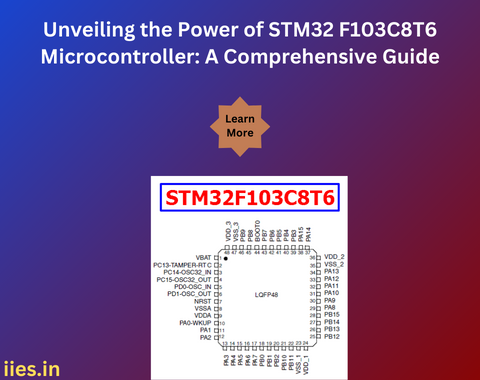
The world of embedded systems and microcontrollers has witnessed a remarkable evolution, and among the numerous options available, the STM32 series stands out as a powerhouse for developers and engineers. In this article, we delve into the STM32 F103C8T6 microcontroller, exploring its features, applications, and the reasons behind its popularity in the embedded systems community.
The STM32 F103C8T6 is part of the STM32 family, which is a series of microcontrollers designed and manufactured by STMicroelectronics. The F103C8T6 is based on the ARM Cortex-M3 core, offering a powerful and energy-efficient computing platform for a wide range of applications.
1. ARM Cortex-M3 Core:
At the heart of the STM32 F103C8T6 lies the ARM Cortex-M3 core, a 32-bit RISC processor that provides a balance between performance and power efficiency. This core architecture makes the microcontroller suitable for both high-performance and low-power applications.
2. Clock Speed and Performance:
The STM32 F103C8T6 operates at a clock speed of up to 72 MHz, providing ample processing power for real-time applications. Its performance is further enhanced by features like a high-speed embedded memory, making it ideal for tasks requiring quick data access.
3. Flash Memory and RAM:
With a flash memory size of 64 KB and 20 KB of SRAM, the F103C8T6 offers sufficient storage for program code and data storage. This memory configuration is crucial for applications with diverse requirements, such as data logging, signal processing, and more.
4. Peripheral Integration:
The microcontroller comes equipped with a variety of peripherals, including GPIO (General Purpose Input/Output) pins, UART (Universal Asynchronous Receiver-Transmitter), SPI (Serial Peripheral Interface), I2C (Inter-Integrated Circuit), and timers. These peripherals enhance the microcontroller’s versatility and enable seamless integration into various projects.
5. Analog-to-Digital Converter (ADC):
For applications that involve analog signals, the STM32 F103C8T6 features a 12-bit ADC. This allows for accurate conversion of analog signals into digital data, making it suitable for sensor-based applications.
1. IoT (Internet of Things):
The STM32 F103C8T6 is well-suited for IoT applications, thanks to its low power consumption and robust processing capabilities. Its integration of communication interfaces like UART, SPI, and I2C facilitates seamless connectivity in IoT ecosystems.
2. Embedded Systems:
Engineers and developers frequently choose the STM32 F103C8T6 for embedded systems development due to its versatility and extensive peripheral support. Whether it’s controlling motors, interfacing with sensors, or managing communication protocols, the microcontroller excels in various embedded applications.
3. Automotive Electronics:
The robustness and reliability of the STM32 F103C8T6 make it suitable for automotive electronics. From engine control units (ECUs) to dashboard displays, this microcontroller plays a vital role in enhancing the performance and efficiency of automotive systems.
4. Industrial Automation:
In industrial settings, where precision and real-time control are paramount, the F103C8T6 finds applications in motor control, PLCs (Programmable Logic Controllers), and other automation systems. Its high clock speed and integrated peripherals make it an ideal choice for demanding industrial environments.
Developers working with the STM32 F103C8T6 typically use the STM32CubeIDE, an integrated development environment provided by STMicroelectronics. This IDE streamlines the development process, offering a range of features such as code generation, debugging tools, and peripheral configuration wizards. Additionally, the microcontroller is supported by the STM32CubeMX tool, which assists in configuring peripherals and generating initialization code.
1. USB Connectivity:
The STM32 F103C8T6 integrates a USB 2.0 full-speed interface, providing a versatile communication channel for various applications. This feature is especially valuable in projects requiring data transfer or communication with a computer, making the microcontroller well-suited for USB-based peripherals, data loggers, and more.
2. CAN (Controller Area Network) Interface:
For applications demanding robust communication in industrial settings or automotive networks, the F103C8T6 comes equipped with a CAN interface. CAN is widely used in applications like automotive systems, industrial automation, and medical devices, and the microcontroller’s support for this protocol enhances its compatibility with a broad range of projects.
3. Real-Time Clock (RTC) and Low-Power Modes:
The inclusion of an RTC module is crucial for applications that require accurate timekeeping. The F103C8T6 features a real-time clock with a dedicated battery backup domain, ensuring that time-sensitive tasks are executed reliably. Moreover, the microcontroller supports low-power modes, enabling energy-efficient operation and extending battery life in battery-powered applications.
1. STM32CubeHAL and HAL Drivers:
Developers benefit from STMicroelectronics’ STM32CubeHAL (Hardware Abstraction Layer), a set of low-level APIs that simplify the configuration and use of the microcontroller’s peripherals. The HAL drivers provide an abstraction layer above the hardware, making it easier for developers to write portable and efficient code.
2. Rich Documentation and Community Support:
STMicroelectronics provides extensive documentation, including datasheets, reference manuals, and application notes, offering comprehensive guidance for developers. Additionally, the STM32 community is active and vibrant, with forums, blogs, and online resources where developers can share experiences, seek assistance, and stay updated on the latest developments.
3. Firmware Libraries and Middleware:
STMicroelectronics offers a variety of firmware libraries and middleware that further expedite the development process. These libraries include functions for common tasks such as USB communication, signal processing, and more. Leveraging these resources allows developers to focus on higher-level aspects of their projects, reducing development time and effort.
The STM32 F103C8T6 microcontroller stands as a testament to the continuous advancement in embedded systems technology. Its combination of the ARM Cortex-M3 core, extensive peripheral support, and versatility has made it a favorite among developers and engineers across various industries. Whether applied in IoT, embedded systems, automotive electronics, or industrial automation, the F103C8T6 showcases its prowess in delivering reliable and efficient performance.
As technology continues to evolve, the STM32 F103C8T6 remains a key player in the world of microcontrollers, contributing to the realization of innovative and groundbreaking projects. Its feature-rich architecture and widespread popularity make it a compelling choice for those seeking a robust and flexible microcontroller solution.
Indian Institute of Embedded Systems – IIES